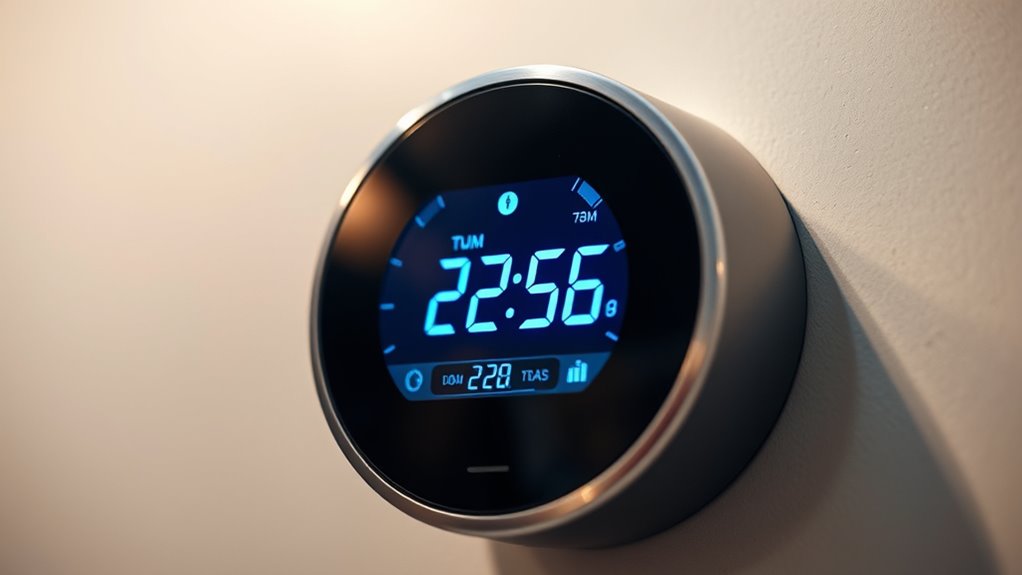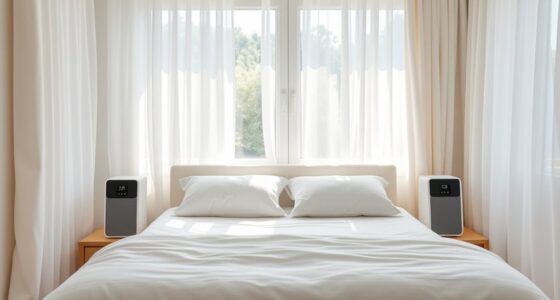When your thermostat shows temperature swings during its learning period, don’t panic—it’s actually gathering data to understand your routines and optimize comfort and energy savings. These fluctuations are intentional and part of the process, not a malfunction. By interacting with your thermostat and giving it time, you’ll help it learn faster and become more responsive. Stick with it, and you’ll enjoy a smarter, more efficient climate control system that adapts perfectly to you. Keep going to find out more.
Key Takeaways
- Temperature swings during the learning phase are normal and part of data gathering for optimal settings.
- The thermostat is analyzing your routines to customize temperature adjustments over time.
- Frequent interaction and manual adjustments can help accelerate the learning process.
- Patience is key; the system will stabilize once enough data is collected.
- Long-term, this process results in improved comfort, energy savings, and a more responsive thermostat.

Have you ever wondered why your smart thermostat takes some time before it starts adjusting to your preferred settings? When you first install or reset your device, it enters what’s called the learning period. During this time, your thermostat isn’t just randomly changing temperatures; it’s gathering data to optimize your comfort and energy efficiency. Think of it as a phase where your thermostat gets to know your routines, preferences, and patterns. This process may involve some temperature swings or unexpected adjustments, but there’s no need to panic. It’s a normal part of the learning curve that ultimately results in a more personalized and efficient climate control system.
In this initial phase, your thermostat analyzes your daily habits—when you typically wake up, leave the house, or go to bed—and begins to adjust accordingly. It’s actively learning your schedule, which allows it to preemptively set temperatures that suit your lifestyle. This user customization helps reduce energy waste because your system isn’t constantly running at full blast when you’re not home or asleep. Instead, it intelligently anticipates your needs, leading to lower utility bills and a more sustainable home environment. While it might seem inconsistent at first, remember that these temperature swings are intentional and part of its learning process. The goal is to create a tailored experience that aligns perfectly with your habits, rather than a one-size-fits-all approach.
During the learning period, you might notice the thermostat making adjustments that seem out of sync with your expectations. Don’t get frustrated; instead, give it time to gather enough data. The more you interact with it—by manually setting temperatures or adjusting schedules—the faster it learns. Many smart thermostats allow you to customize settings during this phase, giving you control over your comfort while still letting the device learn. Your patience now pays off later, as the system will become more intuitive and responsive, creating an optimized balance between comfort and energy efficiency. Additionally, understanding asset division laws can be helpful if you’re considering the division of property or assets during a divorce, ensuring a fair process that considers contributions and future needs.
Frequently Asked Questions
How Long Does the Thermostat Learning Period Typically Last?
The thermostat learning period usually lasts about one to two weeks. During this time, your thermostat’s learning algorithms adjust based on your heating and cooling habits, which involves sensor calibration to guarantee accurate readings. You might notice temperature swings, but don’t worry—this is normal. As it gathers data, the thermostat fine-tunes itself for ideal comfort and efficiency, so give it time to learn your preferences.
Can I Manually Override the Thermostat During the Learning Phase?
You can manually override your thermostat during the learning phase, giving you temporary user control. About 75% of smart thermostats allow manual adjustments without disrupting the learning process. This feature helps you stay comfortable while the system adapts. Just remember, manual overrides are usually temporary, and the thermostat will resume its automatic programming once the learning period ends. Use it wisely to balance comfort and efficient learning.
What Should I Do if the Thermostat Isn’T Learning Properly?
If your thermostat isn’t learning properly, try manual adjustment to see if that helps stabilize the settings. If issues persist, reset the settings to their default state and restart the learning process. Make sure your thermostat is correctly positioned and free from drafts or obstructions. Sometimes, giving it a little time after these steps allows it to adapt better. If problems continue, consult the manufacturer’s instructions or customer support.
Does the Learning Period Impact Energy Efficiency?
During the learning period, your thermostat can improve energy savings by up to 10%, making your home more efficient. This phase might cause temperature swings, but they’re temporary. The learning process helps balance user comfort and energy efficiency by adapting to your routines. So, don’t worry—once it’s finished, you’ll enjoy consistent comfort and lower energy bills, thanks to the smart adjustments your thermostat learns over time.
Are Certain Environments Better Suited for Smart Thermostat Learning?
Certain environments are better suited for smart thermostat learning, especially those with stable temperatures and minimal manual configuration needs. If your space has consistent conditions, the thermostat can more accurately calibrate sensors and adapt efficiently. Conversely, frequent manual adjustments or sensor calibration challenges can hinder learning. So, for ideal results, keep your environment stable and guarantee your thermostat’s sensors are properly calibrated, allowing it to learn and optimize effectively.
Conclusion
During the thermostat learning period, don’t panic at the swings—you’re in a bit of a dance, not a disaster. Just like waiting for the first rays of dawn, your system’s adjustments are part of the process. Trust that it’s learning your preferences, even if it feels like a jarring trip through time. Soon enough, your home’s comfort will settle in, smooth as silk. Remember, patience is your best ally—Rome wasn’t built in a day, nor was perfect climate control.









